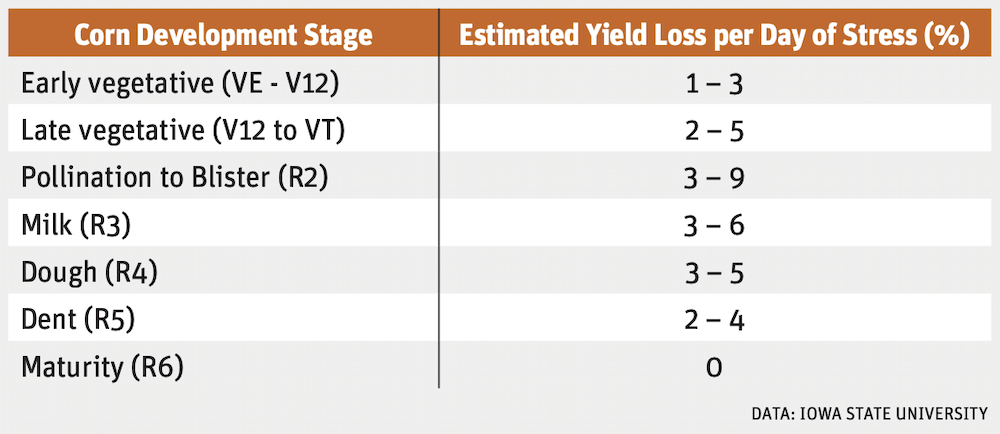Extended dryness is affecting corn and soybean fields across much of Ontario’s main growing regions. Such conditions allow decades of improvements in drought tolerance genetics to shine.
“I remember in 1988, the tap was basically off until early July. It was two months of the driest early season on record,” says Russ Barker, Pioneer sales representative and certified crop adviser based near St. Marys.
Why it matters: Drought stress affects corn and soybeans differently, but is generally more of a problem for corn. Overly dry conditions around and between VT and R4 growth stages can have significant impacts on yield, with the R2 stage being most critical.
Read Also

New Iridium technology helps block GPS spoofing
A tiny new chip will allow Iridium’s Positioning, Navigation and Timing (PNT) signals to be received much smaller devices, create a backstop against Global Positioning Systems (GPS) spoofing.
“Good crop in those days would run 150 bushels. Yields in that drought environment then were half that, even on good soils. Today our top-drawer fields put 200 or 250. If you gave genetics the same kind of stress, in severe drought, they would likely go in the 150-160 range.”
A 100 bushel per acre drop is substantial. It highlights the fact that prolonged dry conditions can still have a major impact on even the toughest drought-tolerant corn varieties.
And while conditions this year haven’t reached the extremes of 1988, Barker says lack of appreciable moisture since June 7 is in stark contrast to the three inches typically received in that time.
As the tassel period approaches, more moisture is needed to stem significant yield losses.
Medium soils like the clay loams surrounding Barker’s area are comparatively forgiving in dry conditions, since roots can extend into the soil profile with greater ease. This is a boon not afforded to those working heavy clays.
Regardless of soil type, Barker says genetics and management improvements by growers have played a significant part in building yields.

Soybeans time yet to come
Soybeans need moisture most during the pod-filling period in August, says Barker. Dry conditions in late June and early July are less concerning.
Corn shows stress by curling leaves and soybeans indicate drought stress through diminished vegetative growth, or by flipping leaves with the underside upward. In severe drought conditions, Iowa State University extension resources say leaf trifoliates will close or clamp together, with the centre leaflet sandwiched between the outside leaflets.
According to Iowa State University, “soybean root growth increases during drought conditions because plant carbohydrates are shifted to root growth. When adequate rainfall or soil moisture returns, vegetative growth will resume until the mid-seeding filling stage (R5.5).
“Under severe drought stress, soybean flowering may occur earlier than normal in an effort to produce seed before premature death… Drought can reduce pod number by up to 20 per cent as a result of flower and pod abortion. Seeds per pod and seed size can also be affected by drought stress but to a lesser extent than the number of pods.”
It summarizes by noting drought effects on soybean are generally not as severe as on corn thanks to overlapping stages of development.
Benefits of dry conditions
Drought has some upsides. It can reduce disease pressure. For tar spot, the latest major corn disease to spread into Ontario, social media posts from Ontario government field crop pathologist Albert Tenuta indicate continued dry conditions should give reprieve.
“As observed last year in Ontario, leaf wetness and duration (are) key to subsequent TS [tar spot] development, spread and last years regular rain events in July/August helped accelerate TS,” said Tenuta via Twitter on July 7. “If conditions stay dry, Ontario is likely to see less and slowed TS development based on previous U.S. experience.”
Barker says improved genetic drought-tolerance is one of several yield-affecting factors, along with soil health, type and management practices.
“Nothing is perfect when it comes to drought tolerance. It’s always a balancing act. You can have fantastic drought tolerance but poor disease tolerance,” he says.
“It’s never an either or. It’s always a compromise… Breeders have made significant progress in tolerance to diseases, and the ability of current genetics to crank out additional yields.”
Improving corn resilience to early-season drought
- Ensure adequate potassium fertility.
- Reduce or eliminate spring tillage, if possible, to preserve soil moisture.
- Avoid planting too shallow. Target a depth of approximately two inches in most situations.
- Ensure good seed to soil contact at planting.
- Manage soils to improve structure and water-holding capacity and minimize compaction.
Source: Pioneer Agronomy – Vol. 13, No. 14, June 2021















